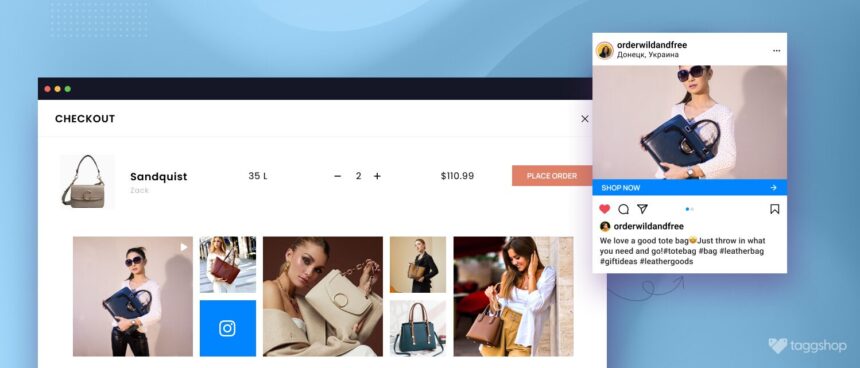Social commerce has come to the fore in recent years on the back of a rise in eCommerce, the boom in social media use, and other technological advancements.
With social commerce still fresh, not all brands and businesses are aware of its potential and looking for inspiration.
This blog contains the top 5 social commerce examples that achieved tremendous success through social commerce. Let’s get started! But first, let’s understand social commerce in brief.
Social Commerce – An Overview
Social commerce is another term for social shopping. Simply put, this is an intersection of eCommerce and social media. You tag your products into social media content and allow users to buy them directly through this Shoppable content.
5 Social Commerce Examples
Nike Air Jordan Taking Advantage Of Snapchat
Nike was the first brand to sell products directly through Snapchat in 2018. The two brands collaborated to create a unique purchasing experience for the 2018 NBA All-Stars game after-party to help launch its new Air Jordan III and to demonstrate Snapchat’s social commerce functionality.
Those who attended the after-party could scan exclusive Snap codes, open the app, and buy the shoes through Snapchat. Even better, the company offered same-day delivery, so anyone who purchased shoes through Snap received them by 10:30 p.m. that night.
More excitingly, users were already in a Snapchat mindset because Nike geofenced the arena during the game, allowing everyone inside to access a unique 3D augmented reality Snapchat lens about Michael Jordan.
Every pair of Air Jordan IIIs was gone in less than 23 minutes.
Since then, Snapchat’s social commerce functionality has grown. Snapchat is now the go-to platform for augmented reality e-commerce, allowing brands to create AR filters of their products that users can virtually ‘try on’ in-app before clicking on a link to make a purchase.
100% Pure Using Pinterest To The Best Effect
100% Pure began in a farmhouse in the American state of California and has since expanded to sell to millions in dozens of countries. It’s a digitally savvy brand, so it’s no surprise that 100% Pure’s marketing team has taken advantage of Pinterest’s highly visual platform.
Pinterest serves as a digital storefront for 100% Pure. Products are meticulously classified, making it extremely simple to find what you’re looking for. The company also uses Pinterest to discuss philanthropy, inspiration, product ingredients, tutorials, how its products are made, and other topics.
Users can learn more about the products displayed on Pinterest by clicking on them and proceeding to a purchase page. With Promoted Pins, 100% Pure can also advertise its products in other app areas, capturing the attention of users looking for alternative brands.
Eureka Street Furniture Using Shoppable Instagram & UGC Gallery
Eureka Street Furniture, a well-known Australian furniture store, is a prime example of social commerce. They have shoppable Instagram and shoppable UGC galleries on their website.
They got in touch with a social commerce platform to create and publish these shoppable social galleries where their own Instagram brand posts are featured in a shoppable Instagram gallery.
The shoppable UGC gallery displays visual UGC from social media platforms where they have been tagged or mentioned. The social commerce platform curated this UGC from social media-tagged products to it and then published it as “INSPIRATION” on its website.
MeUndies Using Instagram Shoppable Posts
MeUndies is making the most of shoppable Instagram posts. The brand’s audience notices strategically placed dots on modeled products when a post is viewed. Viewers can learn more and purchase by tapping the dots or the “View Products” button.
Despite their youth, shoppable posts quickly become the backbone of social commerce. As a result, getting them right may take some time and experimentation.
Ensure that images aren’t overburdened with product tags, and try to lead interested viewers to a purchase option in as few steps as possible.
Use engaging imagery to increase the number of shoppable posts. This can be branded or user-generated, but it should show your product in action. Include descriptive tags as well as detailed product pages.
When someone visits your Facebook Shop, they will have all the information they need to purchase.
Dollar Shave Club Harnessing Social Proof
Dollar Shave Club is another famous social commerce example. It is up to brands to either build or destroy their followers’ trust.
Even if current customers are not afraid to spend, brands should do everything possible to earn their customers’ trust.
Social proof is one of the most important and valuable marketing tools for any business or brand.
In an eCommerce space rife with competition, positive customer feedback acts as powerful social proof. This will not only help you stand out from the crowd, but it will also help you gain the trust of your customers.
Consider Dollar Shave Club, which has a Pinterest board dedicated to positive customer feedback and unboxing photos.
This clever combination of user-generated content and social proof results in a double whammy of real-life social commerce.
This aids in developing brand trust, authenticity, credibility, and more profitable returns.
Wrapping Up
Here are the top 5 social commerce examples that will surely inspire you, given the success they achieved.
Author BioSaurabh Sharma is a Digital Marketing Executive at Taggbox, a leading UGC platform. He has three years of experience in the Information Technology industry. He spends his time reading about new trends in Digital Marketing and the latest technologies.



